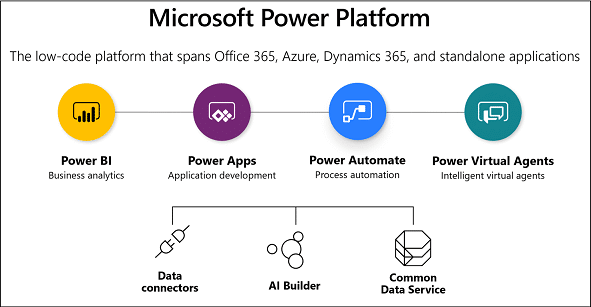You’ve probably aware of Microsoft Power Apps but aren’t clear what they are or how they may help your company. We’ll look at the business advantages of the tool in the following article.
What are PowerApps?
Power Apps is a Microsoft service that allows any business to develop diverse applications to fit their particular requirements. These solutions enable any customer with an understanding of Office 365 to construct a range of applications without necessarily knowing how to program. All that is required for the customer to begin developing internal applications and gateways for external usage is an instruction in the consumption of the Power Apps platform.

Different Types of Power Apps
There are three sorts of Power Apps that can be utilized to create apps:
Canvas Applications: Customers begin with the raw data, then add algorithms, and lastly construct the structure, much like they would if they were working with a white canvas. Compared to a model-driven system, this method gives more features.
Model-Driven Applications: In model-driven apps, the link and data supplied into the application govern a majority of the layout. what you give in usually determines the result. If the program you’re building involves a complex economic strategy, this technique is more frequent.
Gateways: for constructing websites (portals) that could be accessed both externally and internally and enables customers to safely engage with Dataverse contents.
Microsoft Power Apps #1 Advantages
1. Resolving Business Problems
When a single solution isn’t possible, Microsoft Power Apps can create a custom approach to mitigate your business complications. Here are some explanations:
Paid holidays for employees: Design a vacation app where staff may enter their vacation dates. To accept or disapprove queries, implement a Power Automate approval procedure.
Source generation from sales: Rather than waiting till employees arrive at work, enable your field representatives to acquire data using an app. Data can be collected quickly using tools like business card scanners.
Meeting membership: Develop an online booking application that facilitates participants to enroll and verify, then dynamically collects their information in your database.
Worker costs: This software allows your staff to submit information about any expenditures and upload photos of documents for simple monitoring.
Because of the flexibility of Power Apps, you can develop a program for any inefficiency in your company.
2. Mobile Accessibility
Staff may access their applications from everywhere because they are meant to be accessible via portable apps or a web-based interface. One advantage of running Power Apps on a smartphone or mobile phone is that you may use the digital phone feature to take the footage, recordings, and fingerprints, as well as fill out responsive fields.
3. No-code, low-code strategy
The ‘low-code strategy to application programming’ distinguishes Power Apps from other options. This signifies that anyone, including those with no technological background, can create an application. Even though it’s important to mention that individuals who would like to make their applications have a lot of challenges unless you’re a professional, you must collaborate with your Microsoft Associate to build and create beyond the most basic apps.
When opposed to older design approaches, one of the main advantages of a low-code strategy is that it is considerably quicker to deliver an application.
4. Cost-effectiveness
In contrast to Power Apps, traditional software creation may be expensive and complicated. The power Apps Registration starts at £3.80 Per User/Per-App Monthly, and production efficiency can be improved to a minimum thanks to the low-code technique.
5. Microsoft Tool Integration
One of the key benefits of the Power Application Framework is that, as a Microsoft product, it has complete integration capabilities with other Microsoft technologies. Developers can use information from Microsoft programs as well as information from third-party sources. There are a variety of connections available for Power Apps, allowing for smooth integration with other systems.
6. Assurance of safety
The Microsoft Data verse, which employs a security model, is used by Power Apps. For consumers, this implies that security tasks may be created based on a combination of the right of access, ensuring that staff only access material that is relevant to their specific position. When companies initially engage in Power Apps, they may be concerned regarding access privileges and the ability to limit specific data within the application. Microsoft, on the other hand, has included features to verify that the applications are protected, and rights can be issued as needed.
Conclusion
Businesses benefit greatly from PowerApps. They aid in increasing productivity, enhancing coordination, and keeping a company current with the newest developments. PowerApps are also a terrific tool to assist a company gain greater visibility.






